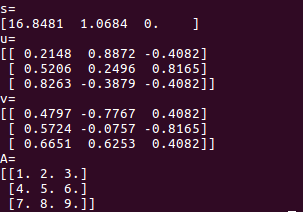In this tutorial, we will write an example for computing SVD value with TensorFlow. You can exercise this example by update our example code.
import tensorflow as tf;
import numpy as np
A = tf.constant([[1,2,3],[4,5,6],[7,8,9]], dtype=tf.float32)
s, u, v = tf.svd(A)
A2 = tf.matmul(tf.matmul(u, tf.diag(s)), tf.transpose(v))
init = tf.global_variables_initializer()
init_local = tf.local_variables_initializer()
with tf.Session() as sess:
sess.run([init, init_local])
np.set_printoptions(precision=4, suppress=True)
s, u, v,a2 = (sess.run([s, u, v, A2]))
print 's='
print s
print 'u='
print u
print 'v='
print v
print 'A='
print a2
Notice:
You must know we also can caculate SVD in Numpy and you should know the difference between them, especial for V matrix.